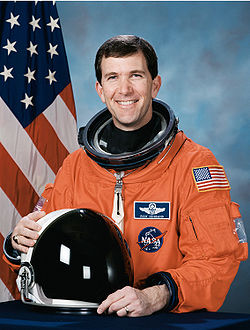Rick Husband
| Rick Douglas Husband | |
 | |
| NASA-astronaut | |
|---|---|
| Född | 12 juli 1957 Amarillo, Texas |
| Död | 1 februari 2003 (45 år) |
| Tid i rymden | 25 dagar, 17 timmar, 33 minuter |
| Urvalsgrupp | Astronautgrupp 15 |
| Uppdrag | STS-96, STS-107 |
| Uppdragsemblem | |
| Utmärkelser | |
Rick Douglas Husband, född 12 juli 1957 i Amarillo, Texas, död 1 februari 2003 ovanför Texas, var en amerikansk astronaut uttagen i astronautgrupp 15 den 9 december 1994.
Eftermäle
2004 tilldelades han Congressional Space Medal of Honor.
2006 namngavs månkratern Husband efter honom, kratern är belägen i Apollokratern på månens baksida.
Även asteroiden 51823 Rickhusband är uppkallad efter honom.[1]
Orbital ATK:s rymdfarkost Cygnus CRS OA-6 var uppkallad efter honom.
Familjeliv
Husband var gift med Evelyn J. Neely och paret fick två barn ihop.
Karriär
Husband sökte in som astronaut redan till astronautgrupp 14 men blev inte uttagen.
Rymdfärder
Husband har gjort två rymdflygningar och omkom i slutet av den andra rymdfärden när rymdfärjan Columbia förstördes under återinträdet i jordens atmosfär.
STS-96
Var pilot ombord på STS-96/Discovery mellan 27 maj och 6 juni 1999.
STS-107
Var befälhavare ombord på STS-107/Columbia mellan 16 januari och 1 februari 2003, när hela besättningen om sju astronauterna ombord förolyckades under återinträdet i jordatmosfären.
Externa länkar
Källor
”Biographical Data” (på engelska) (PDF). NASA. maj 2004. https://www.nasa.gov/wp-content/uploads/2016/01/husband_rick.pdf?emrc=75860a. Läst 11 maj 2024.
- ^ ”Minor Planet Center 51823 Rickhusband” (på engelska). Minor Planet Center. https://www.minorplanetcenter.net/db_search/show_object?object_id=51823. Läst 7 september 2018.
|
Media som används på denna webbplats
Richard Husband, American astronaut who died during the failed re-entry of Space Shuttle Columbia.
Designed by the crew members, this is the mission insignia for the STS-96 space flight, the second Space Shuttle mission dedicated to the assembly of the International Space Station (ISS). The crew patch highlights the major themes of the Station Program: Earth-directed research, the advancement of human space exploration, and international cooperation. The Space Shuttle Discovery is depicted shortly after reaching orbit as the crew prepares to carry out the first docking with the new Station. At this early stage in its construction, ISS consists of two modules: Zarya and Unity, shown orbiting Earth. The triangular shape of the patch represents building on the knowledge and experience of earlier missions, while the three vertical bars of the astronaut emblem point toward future human endeavors in space. The five-pointed star that tops the astronaut emblem in this depiction is symbolic of the five space agencies participating in the development of ISS: NASA, the Russian Space Agency, the European Space Agency, the National Space Development Agency of Japan, and the Canadian Space Agency. The blend of red, white, and blue is a tribute to the nationalities of the crew members who are from the United States, Canada, and Russia.
STS107-S-001 (May 2001) This is the insignia for w:STS-107, which is a multi-discipline microgravity and Earth science research mission with a multitude of international scientific investigations conducted continuously during the planned 16 days on orbit. The central element of the patch is the microgravity symbol, µg, flowing into the rays of the astronaut symbol. The mission inclination is portrayed by the 39 degree angle of the astronaut symbol to the Earth's horizon. The sunrise is representative of the numerous experiments that are the dawn of a new era for continued microgravity research on the International Space Station and beyond. The breadth of science conducted on this mission will have widespread benefits to life on Earth and our continued exploration of space illustrated by the Earth and stars. The constellation Columba (the dove) was chosen to symbolize peace on Earth and the Space Shuttle Columbia. The seven stars also represent the mission crew members and honor the original astronauts who paved the way to make research in space possible. The Israeli flag is adjacent to the name of the payload specialist who is the first person from that country to fly on the Space Shuttle.




